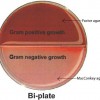 Mastitis is the most common disease in dairy cattle and is estimated to cost dairy farmers $179 a case. When farmers detect clinical mastitis, they usually take immediate action with antibiotics; but many cases either do not need antimicrobial treatment, resolve without treatment, or are not effectively treated by the antimicrobial used. A selective treatment approach can be more effective. This two-step strategy involves first identifying the pathogen, then deciding on a treatment — this would decrease the use of antimicrobials as well as treatment-associated costs for the farmer. This 5-page fact sheet was written by Kathryn Merriman, Fiona Maunsell, Corwin Nelson, and Albert De Vries, and published by the UF Department of Animal Sciences, December 2014. (Photo: University of Minnesota Laboratory for Udder Health, 2004)
Mastitis is the most common disease in dairy cattle and is estimated to cost dairy farmers $179 a case. When farmers detect clinical mastitis, they usually take immediate action with antibiotics; but many cases either do not need antimicrobial treatment, resolve without treatment, or are not effectively treated by the antimicrobial used. A selective treatment approach can be more effective. This two-step strategy involves first identifying the pathogen, then deciding on a treatment — this would decrease the use of antimicrobials as well as treatment-associated costs for the farmer. This 5-page fact sheet was written by Kathryn Merriman, Fiona Maunsell, Corwin Nelson, and Albert De Vries, and published by the UF Department of Animal Sciences, December 2014. (Photo: University of Minnesota Laboratory for Udder Health, 2004)
http://edis.ifas.ufl.edu/an306
Tag: Albert De Vries
When Should We Stop Breeding Dairy Cows?
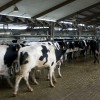 The decision of when to start and when to stop breeding cows during a lactation is often a challenging one for dairy producers. This 3-page fact sheet presents practical rules on how to determine when to stop breeding Holstein dairy cows based on persistency of milk production and break-even point for milk production. Written by Klibs N. Galvão and Albert De Vries, and published by the UF Department of Veterinary Medicine-Large Animal Clinical Sciences, July 2014.
The decision of when to start and when to stop breeding cows during a lactation is often a challenging one for dairy producers. This 3-page fact sheet presents practical rules on how to determine when to stop breeding Holstein dairy cows based on persistency of milk production and break-even point for milk production. Written by Klibs N. Galvão and Albert De Vries, and published by the UF Department of Veterinary Medicine-Large Animal Clinical Sciences, July 2014.
http://edis.ifas.ufl.edu/vm202
Should You Breed Cows during the Summer in the Southeastern United States? An Economic Analysis of a Dairy Herd in Florida
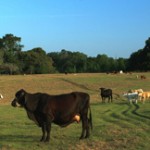 In the southeast United States, since dairy cows experience decreased reproductive performance during the hot and humid summers, some dairy farmers delay breeding until the cooler fall. But there is no economic data to support this practice. This 3-page fact sheet presents the results of a recent paper that evaluated the effects that delaying breeding during the summer has on cow performance and profitability in Florida. Written by Klibs N. Galvão and Albert De Vries, and published by the UF Department of Veterinary Medicine-Large Animal Clinical Sciences, July 2014.
In the southeast United States, since dairy cows experience decreased reproductive performance during the hot and humid summers, some dairy farmers delay breeding until the cooler fall. But there is no economic data to support this practice. This 3-page fact sheet presents the results of a recent paper that evaluated the effects that delaying breeding during the summer has on cow performance and profitability in Florida. Written by Klibs N. Galvão and Albert De Vries, and published by the UF Department of Veterinary Medicine-Large Animal Clinical Sciences, July 2014.
http://edis.ifas.ufl.edu/vm195
Florida Dairy Industry Statistics: Economic Measures (AN287)
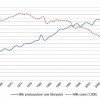 This 7-page fact sheet brings together key economic and price data about Florida’s primary dairy industry collected by the U.S. Department of Agriculture (USDA). Written by K.G. Arriola and A. De Vries, and published by the UF Department of Animal Sciences, February 2013.
This 7-page fact sheet brings together key economic and price data about Florida’s primary dairy industry collected by the U.S. Department of Agriculture (USDA). Written by K.G. Arriola and A. De Vries, and published by the UF Department of Animal Sciences, February 2013.
http://edis.ifas.ufl.edu/an287
Florida Dairy Industry Statistics: Herd Performance Measures and Benchmarks (AN286)
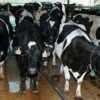 This 8-page fact sheet summarizes technical performance data of dairy herds in Florida and the Southeast United States collected through the Dairy Herd Improvement (DHI) program. Written by K.G. Arriola and A. De Vries, and published by the UF Department of Animal Sciences, February 2013.
This 8-page fact sheet summarizes technical performance data of dairy herds in Florida and the Southeast United States collected through the Dairy Herd Improvement (DHI) program. Written by K.G. Arriola and A. De Vries, and published by the UF Department of Animal Sciences, February 2013.
http://edis.ifas.ufl.edu/an286
The Use and Economic Value of the 3K SNP Genomic Test for Calves on Dairy Farms (AN270)
 The availability of genomic tests is rapidly changing genetics in the dairy industry. AI companies have been using genomics to select AI sires. Now also commercial dairy producers can find value in testing their calves to help decide which ones to keep. This 5-page fact sheet was written by Albert De Vries, David T. Galligan, and John B. Cole, and published by the UF Department of Animal Science, September 2011.
The availability of genomic tests is rapidly changing genetics in the dairy industry. AI companies have been using genomics to select AI sires. Now also commercial dairy producers can find value in testing their calves to help decide which ones to keep. This 5-page fact sheet was written by Albert De Vries, David T. Galligan, and John B. Cole, and published by the UF Department of Animal Science, September 2011.
http://edis.ifas.ufl.edu/an270
Management of Reproduction in Dairy Herds with Natural Service or Timed Artificial Insemination (AN262)
 Both natural service and artificial insemination programs can work for managing reproduction on dairy farms. This 3-page fact sheet provides comparison of reproductive performance and economic considerations. Written by Fábio S. Lima, Albert De Vries, Carlos A. Risco, and José E.P. Santos, and published by the UF Department of Animal Science, June 2011. (UF/IFAS Photo: Thomas Wright)
Both natural service and artificial insemination programs can work for managing reproduction on dairy farms. This 3-page fact sheet provides comparison of reproductive performance and economic considerations. Written by Fábio S. Lima, Albert De Vries, Carlos A. Risco, and José E.P. Santos, and published by the UF Department of Animal Science, June 2011. (UF/IFAS Photo: Thomas Wright)
http://edis.ifas.ufl.edu/an262
AN249 Dairy Business Analysis Project: 2008 Financial Summary
AN249, a 17-page illustrated report by A. De Vries, M. Sowerby, L. Ely, and R. Giesy, summarizes the financial performance of 14 dairy farms that participated in a 2008 survey. It is intended for general use by dairy farmers, the allied industry, government, and educational professionals. Published by the UF Department of Animal Science, August 2010.
http://edis.ifas.ufl.edu/an249
AN242 Effect of Sexed Semen on Dairy Heifer Supply from 2006 to 2012
AN242, a 7-page illustrated fact sheet by Albert De Vries, describes the estimated impact of the use of sexed semen on the national dairy heifer supply. Includes references. Published by the UF Department of Animal Sciences, May 2010.
http://edis.ifas.ufl.edu/an242
AN215 Florida Dairy Farm Situation in 2009
AN215, a 3-page illustrated fact sheet by Albert De Vries and Russ Giesy, presents an analysis of the depressed profitability expected for Florida dairy production in 2009. Includes references. Published by the UF Department of Animal Sciences, March 2009.
http://edis.ifas.ufl.edu/AN215
AN214 The Economics of Sexed Semen in Dairy Heifers and Cows
AN214, a 13-page fact sheet by Albert De Vries, summarizes the recent literature on sexed semen
use in dairy heifers and cows and evaluates the economics of the use of sexed semen in heifers and cows. Includes references. Published by the UF Department of Animal Sciences, March 2009.
http://edis.ifas.ufl.edu/AN214
AN200/AN200 Florida Dairy Farm Situation and Outlook 2008
AN200, a 4-page fact sheet by Russ Giesy, Albert De Vries, and Jay Giesy, describes the situation, outlook, and challenges and opportunities for Florida dairy production in 2008. Published by the UF Department of Animal Sciences, July 2008.
http://edis.ifas.ufl.edu/AN200